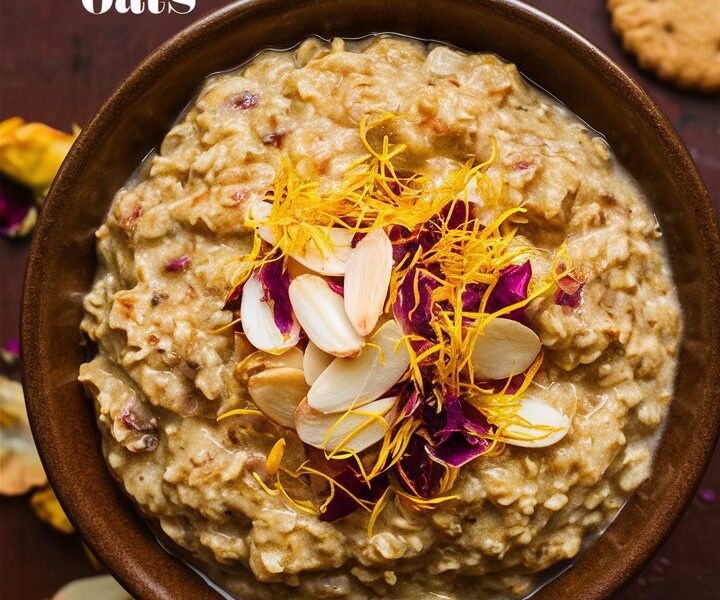Breakfast has always been celebrated as the most important meal of the day. Across cultures, it sets the tone for energy, mood, and productivity. In recent years, overnight oats have gained worldwide popularity because of their convenience and nutritional value. But when you merge this modern breakfast trend with the depth of Ayurvedic wisdom and Indian flavors, you get something extraordinary: Indian Overnight Oats.
Unlike the typical Western overnight oats that rely on vanilla, cinnamon, or berries, Indian-style overnight oats celebrate ingredients like turmeric, saffron, cardamom, rose water, pistachios, and almonds. These elements not only enrich the taste but also bring centuries of wellness practices into a single jar.
This guide is not just another recipe—it’s an exploration of how a simple breakfast can embody nourishment, tradition, and modern convenience. By the end, you’ll know how to prepare Indian overnight oats, why it’s beneficial, how to customize it, and how to make it part of your lifestyle.
Why Overnight Oats Are Worth the Hype
Before diving into the Indian-inspired version, let’s quickly address why overnight oats became so beloved worldwide.
- Convenience: Just soak ingredients overnight, and your breakfast is ready by morning.
- Nutrition-packed: Oats are rich in fiber, protein, and slow-digesting carbohydrates.
- Customizable: From sweet to savory, fruity to nutty, the possibilities are endless.
- Digestive-friendly: Soaking oats reduces phytic acid, making nutrients more bioavailable.
- Portable: Perfect for busy mornings, work lunches, or travel.
Now imagine layering all these benefits with the flavors and healing powers of Indian spices—you get something truly special.
What Makes Indian Overnight Oats Different?
Indian overnight oats stand apart from traditional versions for several reasons:
- Spice Profile: Instead of cinnamon and vanilla, we use turmeric, cardamom, saffron, ginger, or rose water.
- Ayurvedic Influence: Ayurveda, India’s ancient system of medicine, values foods that balance digestion, immunity, and mental clarity. Turmeric, cardamom, and nuts are all Ayurvedic superstars.
- Natural Sweeteners: Instead of refined sugar, Indian-style oats use dates, jaggery, or honey.
- Protein Boost: Nuts, yogurt, and sometimes chickpea flour-based add-ins make it more filling.
- Flavor Inspiration: These oats borrow notes from beloved Indian desserts like kulfi, kheer, lassi, or masala chai.
This combination makes them not just a meal but an experience.
Ingredients: Building Blocks of Flavor & Nutrition
Here’s a breakdown of what typically goes into Indian Overnight Oats—and why each ingredient matters.
- Oats (rolled oats preferred): Provide fiber, satiety, and slow-release energy.
- Milk (dairy or plant-based): Adds creaminess; coconut, almond, and oat milk are excellent for richness.
- Yogurt (optional): Enhances gut health with probiotics.
- Turmeric: Anti-inflammatory, supports immunity and digestion.
- Cardamom: Adds a sweet, floral aroma; helps with bloating and gut comfort.
- Saffron: Luxurious spice known to lift mood and balance hormones.
- Nuts (almonds, pistachios, cashews): Provide crunch, protein, and healthy fats.
- Natural sweeteners (dates, honey, jaggery): Offer sweetness with added minerals.
- Rose water or rose petals (optional): Infuse a delicate floral note.
- Fresh fruit: Seasonal fruits like mango, banana, or berries balance the richness.
Step-by-Step: How to Make Indian Overnight Oats
Step 1: Prepare the Base
- In a mason jar or bowl, combine ½ cup rolled oats, ½ cup milk (or plant-based alternative), and ¼ cup plain yogurt.
Step 2: Add the Spices
- Mix in ½ teaspoon turmeric powder, ¼ teaspoon cardamom powder, and, if available, a few saffron strands soaked in warm milk.
Step 3: Sweeten Naturally
- Stir in 1–2 teaspoons honey, maple syrup, or finely chopped dates.
Step 4: Add Nuts & Seeds
- Fold in 1 tablespoon chopped almonds and 1 tablespoon pistachios for crunch and satiety.
Step 5: Chill Overnight
- Cover and refrigerate for at least 6 hours.
Step 6: Serve & Garnish
- In the morning, stir and top with fresh mango, banana slices, or berries, plus extra nuts if desired.
That’s it—no cooking, no fuss, maximum flavor.
Flavor Variations to Try
One of the best aspects of overnight oats is how easily you can switch flavors. Here are some Indian-inspired variations:
- Mango Lassi Oats – Blend mango puree with yogurt, cardamom, and oats.
- Chai Spice Oats – Add cinnamon, clove, nutmeg, and ginger for a chai flavor.
- Rose & Pistachio Oats – Stir in rose water, dried rose petals, and chopped pistachios.
- Golden Milk Oats – Use turmeric, black pepper, and coconut milk for a healing twist.
- Kesar Badam Oats – Add saffron and almond paste for a kulfi-inspired richness.
- Coconut Ladoo Oats – Mix in shredded coconut, jaggery, and cashews.
Each version carries its own identity, yet all stay true to the Indian culinary palette.
The Ayurvedic Connection: Healing from Within
In Ayurveda, mornings are considered a sacred time to nurture digestion and immunity. Here’s why the main spices shine:
- Turmeric: Reduces inflammation, purifies blood, strengthens immunity.
- Cardamom: Improves digestion, combats acidity, enhances mood.
- Saffron: Acts as a natural antidepressant, supports reproductive health.
- Nuts: Grounding, nourishing, and energy-boosting.
- Yogurt: Enhances gut flora, improves metabolism.
This makes Indian overnight oats more than breakfast—it’s functional food.
Nutrition Profile (Per Serving, Approximate)
- Calories: 300
- Protein: 10–12g
- Carbs: 35–40g
- Fiber: 5g
- Fat: 10–12g
- Natural Sugars: 6–8g
Balanced with protein, healthy fats, and slow carbs, this dish keeps you full for hours.
Tips for Perfect Overnight Oats
- Always use rolled oats, not instant, for the best texture.
- Taste and balance sweetness vs spice before refrigerating.
- Add fresh fruit only in the morning to prevent sogginess.
- If you prefer warmth, microwave for 30–60 seconds before eating.
- Adjust consistency: more milk for creaminess, less for thicker oats.
Common Mistakes to Avoid
- Skipping the spices: they are the essence of Indian-style oats.
- Using flavored yogurts: they overpower delicate notes.
- Over-sweetening: let natural flavors dominate.
- Adding nuts too early: they lose crunch; use fresh toppings.
- Rushing the soak: oats need at least 6 hours for best texture.
Meal Prep & Storage
- Batch Prep: Make 4–5 jars for the workweek.
- Storage: Keeps well for up to 4 days in the fridge.
- Travel-Friendly: Use airtight jars for portability.
- Flavor Rotation: Prepare a base mix and switch toppings daily.
How Indian Overnight Oats Compare to Western Versions
- Flavor Depth: Indian spices add warmth and complexity.
- Sweeteners: Dates/jaggery vs refined sugar/maple syrup.
- Protein Sources: Nuts and yogurt are emphasized more in Indian versions.
- Cultural Link: Inspired by desserts like kheer, kulfi, or lassi.
If you’ve been bored of plain oats, this is a flavorful upgrade.
FAQs
1. Can I make it dairy-free?
Yes—use almond, soy, or coconut milk with plant-based yogurt.
2. Is it gluten-free?
Use certified gluten-free oats.
3. Can I eat it warm?
Absolutely—just heat slightly for a pudding-like texture.
4. Is it good for weight loss?
Yes, because it’s high in fiber and protein, which control hunger.
5. Can kids enjoy it?
Yes, just adjust spices to be milder.
Final Thoughts
Indian Overnight Oats are more than just a recipe—they’re a fusion of tradition and convenience. They reflect the richness of Indian flavors while honoring the simplicity of modern meal prep. Whether you’re a health enthusiast, a busy professional, or someone who loves experimenting with global food traditions, this dish deserves a spot in your breakfast rotation.



